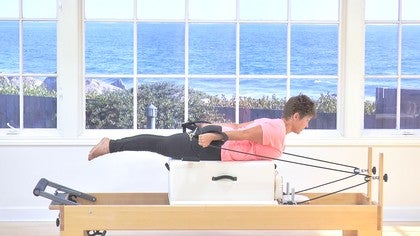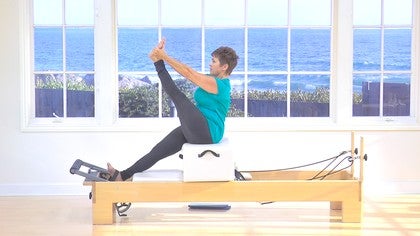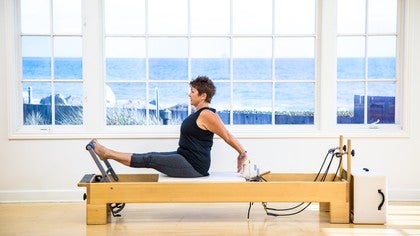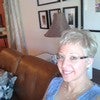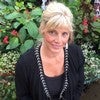Description
About This Video
Transcript
Read Full Transcript
This is number two in our three series reformer workouts that are focusing on fundamentals and basic reformer work. So I'm gonna remind you the abcs a is for activate versus aggravate. Breathe instead of bulge and connect instead of collapse. We're going to start this reformer workout with footwork and I have it on three red springs. Just a little note about the spring edge is that some times you, there'll be a tendency to put the springs on really heavy when you don't have control of the pelvis. And I caution you against that.
You can certainly make your springs heavier, but I want you to be sure that when you push out an in, you're maintaining the integrity, not overworking in the neck, keeping the neutralness of your spine and things like that. So I'm going to start with three red springs. In this workout, we will be progressing to a flection with resistance.
So we'll start with foot work with our heels on the bar, inhaling, expand, and then exhaling scooping in the belly. Inhale. And then exhale. Recognize the neutralness of your pelvis. Recognize the neutralness of your neck. Arms are down by your side. The feet are pressing down to the floor as if you're taking mud off your feet. That makes the thigh connection right behind your buttocks. Inhale, prepare.
Exhale, press and bend 10 times two as you go through these next five, take the time to check in. Soft neck, Ab Dominion, thighs engaged, and two more. And then last one, let your feet slide down to the bird feet position or prehensile. Curl the toes, drop the heels, recognize the neutralness of the pelvis. And off we go again. This time we're going to inhale, prepare, exhale, press out.
I'm not tensing my shoulders, I'm not tensing my neck. I've got five more
You'll notice here that my thighs are not bulging. I'm not up like this. I'm taking my pelvis, lengthening out my legs, keeping these two pieces going in opposition. This is a really nice connection between your legs and your torso and we'll do eight more here, one and to connection back behind the thighs. Three squeezing inner groins together, four, five and six and seven and eight and bend the knees, heels apart on the bar, making an inner thigh connection. We've already done these in our previous workout, sort of going through these a little bit quicker with a little dynamic movement and now we'll go five more. No movement of the pelvis.
I don't often overly check myself, but I'm just making that point to beginners here that it's important to make the conscientious decision to check in. We'll go to the balls of our feet so the weight is equally distributed across the back of my pelvis. I'm attracting my thighs together as I work to straighten, straighten, straighten, straighten, straighten, and then bend and straighten, straighten straight, and keep the heels lifted. And then Ben, and then last time, and then Ben and rest right there. You know there's a paradox in Palladio's. There's a paradox of concentration. I think we like to focus on concentration a lot in the beginning so that your body can start to make those connections and that little by little you have to actually concentrate less because your body becomes used to the connections that it's making. So now I'm going to roll to my side and come up.
I'm going to change my springs here to two and I'm gonna lie down again and prepare for my arm work and hundred beats and trunk curling. So with my arms over my head and then making the connection right underneath my armpits here, two knees folded. Just recognize this as that fundamental. Sometimes we call it that dead bug position. Pull the arms down and let the arms float up.
So my arms are working on the way down and on the way up. They're decelerating the Movement for control. Three more times. Inhaling and then exhaling two more times. Inhaling and then exhaling, and then last time down and hold that down shape. Broaden your collar bone so you're not rounding your shoulders and then sway your legs to one side and then use that left leg to push it back to center and sway to the other side.
Your shoulder is a ball and suck it. One more time up. And then one more time down holding the strap.
Inhale up and then down. Arms out to the side,
Exhale down. Close, relax, neck. Inhale up open. Exhale down, closed, relaxed, neck pull belly. Last one. Inhale up. Open. Exhale, connect, reverse open. Come up, press down, open. Come up for us down. Last one, open. Come up, press down, feet, come down. Pause right there.
Just hold this position here. Inhale into your back ribs, and then exhale slowly, slowly, slowly roll yourself
[inaudible] arms make a connection as the legs lift. Head nods, front ribs curl. As I reached my arms long and then I unroll all the way down. Last one, we do our hundred beats here. We'll do about 50 today. Head lifts, arms press, legs, float, trunk curls. Off you go.
One more set. Exhaling, hold that girl legs come down, arms come up and pause right there. Put the straps back, put your feet on the bar, press into your heels and then put your head rest down just for a sec and take time here to invite that pelvis up into a curl. And then once you get up, press the arms down, reaching long through the thighs, and then slowly roll your trunk down. Roll your trunk. Let's do that again. If that bridge was a little too high, you can put your feet down here on the platform and you can just do a little pelvic curl if your back got tight during those exercises. So it's always okay to take a little break and roll through the spine.
Well, now switched to the legs in the strap. I remember when you pushed that leg away to engage the back of the thigh. This is a very important piece to the exercise because you don't want to kind of wig out your Essai joint by not being in control of your leg straps. You want to be sure that all your straps are adjusted appropriately so that they don't get a kind of caught up in there. Okay, so press your thighs to this vertical position. Recognize neutral, heavier ribs down. Let's go ahead and put that head rest back up here and just pause right here. Squeezing the heels together. Frogs out
This is a wobbly leg. Okay, so we're going to bring ourselves back down. We're going to connect through the quadricep and the thighs, pressing the leg out. I don't know if you can see that difference, but it's a much more connected leg. Soft point of the toe. Inhale up open. Exhale down, close to more like this and turnout. And now we'll go to parallel. When I go to parallel, I actually feel my middle hamstring a little bit more cause I'm pressing down right here on my inner groin. One more time. And now I'm actually going to turn my toes in and my heels out and I'm going to do three more here.
Respecting the integrity of my pelvis position and my spine position. And now I'm going to reverse the direction of the circle first and turnout
Now I'm going to invite my knees to come back. I'm going to invite my pelvis to curl to stretch my low back without collapsing, changing the position of my head and my chest. So I'm going to let my knees come in and allow the weight of this spring to stretch my lowest back. Almost like I'm doing a fundamental pelvic curl, but the straps are helping me.
Press out open legs with control, close legs bend in. This will become another exercise pattern in our next workout. Lengthen open, close and bend. Lengthen control, close inner thighs. Then the last time, lengthen open close, and then take one leg out, put your foot down and take the other leg out and put your foot down and hang your straps up.
I'm going to put my legs in this direction. Yeah, some people might need to cross their legs. My leg seemed to fit through here. Fine. I'm actually going to push out. I'm going to take my straps and grabbed my handles here and I'm going to do a roll back. Kind of like the how we do in the Mat. Work with a roll up. I'm going to do the rollback portion here. Make sure all my straps are happy, I'm gonna pull my belly and start to pull my shoulder blades back and roll my trunk backwards. Inhaling, exhaling, pause, and now inhale through the back of the ribs as the straps help me come up. Stack. Inhale, exhale, start to roll back.
Now, one red spring is not very heavy here, so if you need a little more help and support, you certainly can add on another spring. One more time. Lengthen your torso up and then exhale. The belly pulls in. Rolling backwards. Trying not to grip your buttocks, but instead roll the spine like you're rolling back to that hundred beat position
So when I take my arms and bring them up into this bicep position right here, my elbows are parallel, my arms are parallel. Instead of rolling back, I'm now going to take my torso and I'm going to lean it back and then bring it up. Inhaling and then exhaling. One more time hindering back in one more time. Hindering up. Now I'm going to combine both of those movements with a rotation. The I'm going to give myself a little more tension so I can change the tension on the strap when I'm working, either by changing the spring or I can actually choke up on the straps, which is what I'm going to choose to do here. So from this shape here, I'm going to stack up my spine, kind of plug my shoulders in, and then length, front ribs and back ribs. I'm going to roll my spine down how I started, and now I'm going to bend my right elbow and twist towards you and then bring myself back to center.
I'm going to hold the curl and twist in the other direction as I bend my left elbow. My right arm really isn't doing anything and then bring myself back and come back to center. One more time. Holding the curl. Inhale, twist, exhale, release. Again. Inhale, twist, exhale, release. Last time. Inhale, twist, exhale, release. Come back to center. Other time other sides accuse me. Inhale and release. Holding the twist, pulling the arm. One more time coming back.
Sit yourself all the way up. Now we're going to add a twist with the hinge. As these exercises progress, you'll see a pattern with around in a hinge adding rotation. That sequence will repeat itself in other reformer exercises. Here's the hinge, here's the rotation, pulling that right arm.
Here's that rotation pulling the left arm. This is tough. Back to center. Sit yourself up again. Hinge, trying not to bold that abdomen as I twist to the right. That is my right lower internal lobe leak to all my students out there bringing shelf back to center and then twisting to the left is my left lower internal back to center. And then bring yourself all the way up. Hmm. Those are great exercises there.
So I'm going to turn myself around now and we're going to get on a little box. I'm going to get myself a little moon box.
Actually, let's program the exercise first just with your arms, recognizing neutrality in your trunk, reaching your legs long up, back and down with the shoulders. Checking in. The arms are by my side. Inhale. Exhale. Inhale. Exhale, arms out, arms down, arms up and around. Say it with me. Arms out, down, up, up, up, around without changing the neck. Okay. Grab your handles and find that position here. Inhale, exhale. Inhale, exhale. No spine moving down. Inhale up. Here's the challenge. No neck change, no Trump change front and back. Ribs, arms in my peripheral vision.
Come down last one. Inhale and exhale, and up and around and down. Very good. Number two, looks like this. Now I'm going to press my arms forward and I'm going to spine stretch. I'm gonna step up, leaving my arms parallel to the floor and then finished like I did in the first one. Inhale. Exhale.
Inhale. Exhale. One more time. Spine stretch forward. Forehead, nose, Chin nods. Inhale. Exhale, inhale, and exhale. You do not have to sit on a box. If your hamstrings and your back are loose enough, we're gonna repeat the exercise, not on the box.
Never hurts to repeat a good exercise a couple of times, not 10 sets of 10, mind you, but just a couple extra time. So here's number one.
Again, if you need to sit on the box and it helps you sit up taller, you certainly can. This exercise here, hug a tree is a very traditional exercise. Going to hug my arms together if I need to. As a beginner, I can actually pitch forward, but I don't want to pitch so far that my belly dumbs out in my head. Does this. So the cue is not just a simply pitch forward. The cue is actually to lean your body forward. A diagonal. It helps you make the connection a little bit more. Looks like this.
Here I am in vertical, I can take this entire shape and just lean it forward. Inhaling. Okay. And then I'm hugging a big tree. Have to check in here with your neck that it doesn't overwork. You may have to hug a little bit lower tree. You may have to hug down here so that you get the motion and get connected through your trunk. One more time. Open. And then one more time close.
And then release and relax. So now you asked the question, are my blades moving? Is My moving or are my arms moving? So many choices. So let's make the decision. Let's first say that the blades don't move and the spine doesn't move. But only the arms. It looks like this. Arms, arms.
So if you were behind me right now, my blades would not be coming away from each other, nor would they be squeezing together like cracking a walnut or anything. It's my arms only moving from a stable blade. And as long as my arms are just at 90 degrees or less, my blade doesn't really have to move at all. Now I'm going to do the arm movement and the Blade Movement as an exercise so that will look like this. Open my arms, squeeze my blades on purpose, pull my arms, protract my blades on purpose, open my arm, squeeze my blades, spine attempts to stay the same. Pull my arms, protract my blades, or pull them away from my spine. Close. One more time. Arms Open, blade, squeeze, and then go down.
So both types of that exercise is both types are good. You just have to make that differentiation when you're doing exercise, which part of your body or which bone you indeed want to move. So let's go ahead and put these straps down here. The next exercise will be short box.
My feet are not resting on the wood anymore. They're actually pulling apart and up. I'm gonna check in with my neutralness of my pelvis lifting up my trunk. My head is in line over my chest and my chest is in line over my pelvis. Arms come out to the side. In the previous segment, we worked the arms up without moving the spine and arms down without moving the spine. Arms Up, and then arms down.
Now we're going to start the curling backwards. So I'm going to scoop in my belly, lengthened my tailbone underneath me and curl back as my eyes stay facing straight ahead, hold and hold, and then curl right up over the trunk and come up. And then my feet will actually fall to the board. Uh, the, the footboard there. As I round my forward, lengthening through the crown of my head stack up to vertical, my feet come away, I roll my trunk back.
So now we're just going to add it here on the short box. I'm going to twist my body to the right attempt to roll down my sacral area and roll down my lowest back as I stay twisted to the right. Come up in that twist. Return Myself Center, twist my torso to the left, try to roll down the flat spiral my spine so I don't lean, but I'm rolling down and then curling up and then bring myself to center. Now I'm going to add it with the hinge. My hands are here to remind myself and of course to remind you that we're not changing there. So I'll try the hinge now with my hands behind my head, just so you can see the spine.
Now I'm going to rotate to the right and I'm going to hinge back. I'm not going to lean over or do. I'm the spearing thing. I'm just doing the rotation and if you don't know that exercise, don't worry. I learned it later and I'm going to hinge back and then sit myself up and come back to center. This is a really tough exercise. I'm going to rotate, hinge, hold that hinge, hold it, and then bring myself up. Come back to center. Last time. Twist, hinge, hold the hinge, relax the neck. Ease of breath, but big challenge here.
Bring myself up. Return to center. We'll advance the climate tree here a little bit. In our first series, we simply did stable spine. Just stretching the hamstring here. Now we're going to take a little rolling back if you will, and hold this shape. Let's start with the left leg coming up. So I'm not sitting up tall here on purpose.
I'm creating a shape of my spine and I'm not changing the shape of my spine just so I can get used to this exercise here. I don't want to focus. It's not that I don't want to focus on sitting up, I just want to focus on not moving my torso as I do this with each of my legs. So I'm maintaining the position of my trunk as I bend and straighten my leg. And then I bring myself forward and I stack up. Now I'm going to do the exercise again with one of my legs underneath the strap and I'm going to pull back and give it some tension.
And now I'm going to see how deep I can make this hip crease and pull my leg up. And now I'm going to try to sit up a little bit taller, take my whole arm and bring it right underneath my thigh and pull my shoulder back. And now you'll see this position is actually a little bit different as well. And my leg may not go as straight, but now the exercise becomes a little bit more challenging to maintain my spine in the upright position as I work the leg one more time and oppress it up and hold and I'm gonna fall, I hex and point and I'm quivering and point. And one more time. Flex. One more time. Point.
Bring the leg down and then return it. That exercise will also build lengthening up tall, pulling my right knee in, getting that hip crease nice and deep. Taking my right hand, bringing it under, lifting my chest, bringing the shoulder back, hanging onto my wrist. Here I'm nice and compact in here. Stretch and bend. I'm pressing my thigh away from me into my arm to lengthen the hamstring, activating my quadricep to stretch my hamstrings. So many great things going on here. And then Ben.
Inhale and then exhale. One more time. Inhale, hold. Flex foot, point, foot, flex and point. One more time. Flex. One more time. Point. Lower the leg down and return it.
I'm going to put the foot bar back down and I'm going to go ahead and do the exercise I did in the previous workout we did overhead press. I'm going to go ahead and do that with one yellow and one blue, so join me for this. We've done it before. I'm going to lie down. Your forehead is on the bar. Your thighs are long and engaged, your hands are on the bar. You'll remember this as a press back and then forward. The elbows are pointing to the floor pressing and then reaching. You're working really hard to not share your neck and do this because that's not the exercise, so put your forehead on the bar.
I'm going to move up just a little bit, much like you're holding something kind of underneath your Chin here, a little bit and press and then return. We're going to build extension here, so I'm going to press and now as I lift my chest, the box moves closer to the bar and my heart reaches and then I lengthen myself down and then I bend my elbows in. My forehead should touch the bone. Inhale, prepare. Exhale, press inhale, come up into extension, not being in a hurry to throw the head back, but letting the heart come forward and then the eyes length and out and then lengthen yourself down and then the elbows to come in. Now that extension part of that exercise gives you what I like to call the feeling. So remember that feeling of extension that you had, especially in your chest. We've worked really hard through the fundamentals to create a connection through the buttocks and the thigh to support the pelvis. So the back can indeed extend, but not only from the lumbar region. So now I'm going to go back to the yellow. I'm gonna lie on my tummy.
The exercise now becomes a little more challenging first because I don't have a any place to rest my head. So now I have to come and understand the relationship in my torso. So my hands are going to come by my side and I'm going to reach for my arms to the ceiling, much like I did in the mat. Fundamental workout and lengthen the chest and then lower myself down. Arms, chest,
I really want to lift up badly, but I'm going to make the connection first through the back of my arms. Last time the arms were pull. Now I'll keep the arms pulling. Then I'll pull more as my chest lifts up and then I'll lower myself all the way down and now I'll put that together. Inhale bones in place, arms lift, chest lifts, eyes look forward and then lower down. One more time. Inhaling, exhaling.
I'll take my arms and lower them down. Give my legs a little break. Incidentally, if I were to be further back on the box this way, it would make the exercise a little bit easier because I wouldn't have to lift my chest quite as much. If I wanted to make the exercise harder without changing the spring, I would move my body off of the box and then I'd have to use more back extensors. So I actually chose to move myself back just a little bit to support my chest just a little bit so that I can get my arms to come in first. You'll notice that my legs are not lifted a mile high. They're just engaged.
Now I'm gonna pull the arms and hold the arms, and now I'm gonna invite the chest boy, those legs sure. Want to lift really quickly, but I'm going to keep that connection through my thighs as I lift my chest and my heart. And then as I release down my arms, attempt to stay parallel to the floor three times in row. That's one. Here's two. Inhaling, exhaling. Last time. Inhale, and last time. Exhale.
Okay, the back of my neck is long. My Tommy is pulled in. It's important in this exercise to just simply hold this and notice what wants to change on me. I kind of want to lift my head, but that's an old pattern, so I'm going to lengthen my skull as if I'm holding something underneath my Chin and engage my legs and I'm going to press back and then the belly scoops deeply as I pull my legs forward and lift my toes. It makes me push my legs, pull my belly as if I'm pulling the carriage all the way in five times in a row. Inhale, exhale.
As my arms connect to my core. You'll notice that the arm angle actually is not changing
Sometimes with a lighter spring it allows you, so I encourage you to try it both ways. We're going to stand up again.
They're engaged. And then press and then pull. So now I have to resist the spring coming back. It's a different kind of work. I feel a little bit more in the out phase, but I'm resisting it coming in. Let's do five, four, three, and two and one and bring it in. And now we'll lower ourself down and we'll get ready for knee stretches.
And then I'm going to go ahead and nod my head as if I'm looking,
And then last one, it's kind of
So a lot of times people come in and they do this to try to get that deep hip crease, but that again, that's an accident waiting to happen in your back. So inhale, exhale, change. Excuse me, do not change the position of your spine. Three more, two more, and then one more. And then bring yourself all the way back up. Inhale here, go back to the bar again, getting ready for your plank, hands on the bar, and to take your toes right in between the head. Put head rest here. Recognize this right here as kind of a kneeling plank and just hold that.
I'm going to shift my body over my hands and lift my legs up and I'm going to hold here. Hold for five and four and three and two and one and drop myself down. In the last fundamental class that we did on the reformer, we had that on three red springs. I'm going to put it back on three red springs and that will keep the carriage a little more steady while I lift up into that plank. See if you can see the difference in my body.
This is with three red springs helping me up in holding and then bending my knees and coming down. This is with two red springs. Is it going to be harder or easier? Harder. Good answer. Okay, so now when I lift up, my body is going to want to change right about here. Oh goodness. And then I've got to hold it and hold it. And now when I go out, I can only go out an inch or two.
So now we'll put it on one red spring and the lower the foot bar down will turn around for chest expansion. We did this exercise in our fundamental workout, teaching our spine, how to stay long in vertical from a kneeling position, making a connection through the buttocks and the thigh, pulling the belly in. I choked up on the straps a little bit and I inhale, pull my arms. Exhale, release. I'd like you to take a special note to my risks and just notice that my wrist nice and long. Now the exercise looks like this. I inhale, pull, look right, look, center.
Exhale, release. Inhale, pull, look left. Look, center, release. Now we'll try to do one. Inhale, looking in both directions. Here we go.
Get that Nice verticalness in your trunk. As you pull you make the connection through your thighs in the back, your buttocks. And now we'll add the breath. One more time. Pull right center release, pull. Left center release seemed like a couple extra repetitions, but as you do that exercise, you become better at organizing the relationship between your thighs and your trunk and your arms. I'm going to put my left strap down. I'm actually going to change to a lighter spring.
Now I'm going to put on the lightest one I have, which is a yellow. I'm going to switch to one arm. You can see that this carriage is actually moving freely here. There is one spring on there, so now I know with one spring that it's going to be really light. I'm gonna put my left hand behind my back to maintain those ribs back there so they don't shorten. I'm going to pull my arm and hold the pole.
Now I'm going to invite my body to do a twist, hold, hold and hold, and then release the arm. Look back to center, make the invitation. Thigh connect belly in arm poles. I begin to twist, I begin to twist, I begin to twist and then come all the way back. Woo. One more time. Arm gets connected, trunk gets connected.
Thighs are engaged to support from below. Ease of breath, return yourself all the way back. Switch sides. Remember that with a light spring, if you pull that spring to our, excuse me, pull the strap too hard. You know that it can kind of give you a little ride and then it goes back slowly. Have to be really careful for safety reasons as well. Belly in shoulders. It's not that the shoulders are pulled back because that gives us a false sense of what posture is. Okay?
Posture is more than simply standing up straight. That's probably another workshop, but posture is really the relationship between your body parts and between your trunk and your extremities. Okay, so arm pulls on the left, I add a twist of the torso and then I untwist and release the arm and face center again. Inhale, twist and twist and twist. Straight elbow engaged, and then bring myself all the way back. Last one. Inhale. Inhale. Inhale. Connect through the buttocks without leaning or lurching, and then bring myself all the way back.
Okay, so when you're facing the back of the reformer and you pull your straps back, you're creating what I like to call an extension force in the spine. When we kneel front, I need a little bit heavier spring, so I'm going to add a blue one to that yellow. And now I'm going to do kneeling, arms facing front. We did this in the preview previous workout, but from here now when you pull the arms facing front, it's going to put a little flection force in your spine. So we have to resist flexing. So I'm going to grab the straps this time instead of the handles because it gives me a little different connection. Now my toes are really curled up into me. Lengthening the front of the hips, belly pulled in. Inhale, circle, exhale, inhale.
So now I actually want to do this. Okay. It's a flection force. I want to do that, but I'm going to resist that so I can create strength in the verticality here. So I'm just going to pull up and then release and pull up and then release. And one more time. Pull and hold and hold and hold and then release. And I put my left strap down.
I'm going to take off the yellow spring right now there's a blue spring. I'm going to take my right arm out in front, take my left on my tummy, and now I'm going to twist my torso and then I'm going to resist it. On the way back, I'm going to keep my head in line with my chest bone here so I don't twist too far with my neck and I get a little more in my trunk. And then one more time, a little more feedback down here. Reach, reach, and reach. And then bring myself all the way back. Again, not a fancy exercise, but a very good one to feed the trunk from the bottom up with the knees in this position. Vertical connections strap facing front.
Take my arm all the way out in front of me. Belly pulls in. I'm going to take a tool with in my trunk as I reach my left arm forward and bring myself back. I feel myself pitching a little bit. I don't really have a mirror, but I'm trying to do it from proprioception, which is tough enough. I'm twisting my trunk and then bringing it all the way back. And then one more time reaching tune with sting holding and then bring it all the way back and down.
I'm gonna put three red springs on. Starting to wind down. We do have a couple exercises left for do, do, running and bottom lift. And then today's workout we're going to add standing blitz. So I'm gonna lie down again. My head rest is up.
Pressing your thighs together or pulling them together if you will, but they're not moving. Just making that connection. And I do a bottom
As a beginner, I don't want you to injure anything between your thighs there, so we're going to step on the stable surface first. Get yourself set. If you can not stand up safely on the reformer, then this exercise really isn't for you and you need some help or somebody can help you do that, so you certainly have to be able to stand up on the reformer and put your leg at the front edge of the reformer. You can try that a couple of times. You can practice on steps. You can practice on the box, stepping up and down just to be safe. So in this position here now, how am I standing? If you were looking at me from the side, my head would be over the center of my chest and my chest would be over my pelvis. My pelvis is in neutral. I'm going to nod my head and just look down at my feet and make sure that they are both indeed parallel. And I'm going to bring my whole torso back up. Now I'm going to give you a little visual here.
I'm engaged in my legs by the way, because there's three springs on here and I'm trying to press it out and I can't, which is a good thing. I just creating that feeling. Okay, so my arms are going to come out to the side. I'm going to hold nice and strong. I'm just gonna Breathe. Inhale an exhale and right now I'm not going to try to use any of my extraneous muscles. I'm going to try to use all my local deep muscles, my diaphragm. Inhale an exhale. Your intercostals are also part of your local system. Inhale, expanding the intercostals and exhale. If you get up into the top of your neck and start to breathe like those become more global exercises, so even in exercise like side splits, you want to get all the breath from coming in here. Okay, I'm going to ship the weight back onto my right leg and I'm going to step down and step off. Now I'm going to change my springs to two red springs.
Don't change your springs while you're on your reformer as a beginner, just safety first. So I stepped off, I took a red spring off and now I have two red springs on. You need to adjust accordingly. When you practice with your reformer or practice with your teacher. The spring age that I've been giving you is really a ballpark figure and it's really as it relates to my size and shape, so it's a little bit different for everybody and that's the beauty of PyLadies as well is that the teacher will meet you where you are at any given point of the exercise, the step on the stable surface. First step up and bring my leg out, glanced down, make sure my legs are parallel. Build up from the bottom, the pelvic floor, the abdomen, relaxing the shoulders. And here we go. Here.
Inhale, exhale. It's work. Inhale, resist it. In two, three I'm going to give you another visual. Your thighbone at the top of your thighbone, there's two balls there. The heads of your femur.
As I press my two legs away, those balls of your femur actually come closer together. So sometimes if you, if you feel like you're really working hard in your feet, if you take the information and bring it more proximal, like more to the center of your trunk, when you push your legs out, you can actually imagine that the balls of your femur are pulling in and then resisted, resisted, resisted. So you wonder why I'm pressing right here or pushing my hand. Not Pushing, but why I'm pointing right here. This is your hip joint. Your hip joint. If you look on a skeleton is oh about a half of fingers, distance from your pubic bone. So you, our hip joints are here. So when we feel things back here, those are muscles.
The ball and socket occur right here. If I had a skeleton, I show it to you, but we don't need to have time to do that right now, so I encourage you to go back and look on your anatomy book and see that that's where your hip joint is. Okay? Five times in a row, the legs push out, the balls kind of pulled together. Inhale and then resist, resist, resist, inhale, and then resist. If you raise your eyebrows, sometimes it helps you. I feel like that's what I do here towards the end of the workout and then return yourself in one more time. Press out in hold, hold which leg is pressing harder? It doesn't really matter. They both are really working and then resist yourself all the way.
You put all the weight on your right leg. Step backwards and step all the way down. Bring yourself around to the other side. Take your leg on the stable surface first. We're just going to keep it on these two springs here.
We're not going to go and put it on the three red ones again cause we've already done that. So I'm going to step it carefully and safely on this non movable surface and put my leg on the reformer. Gonna make a connection back here through my buttocks. My shoulders are up in back, crown in my head, reaching long. All those different connections we've made through all our different segments. And here we go. Push two, three and then release two, three.
You know that this spring will be too heavy if your pelvis does this because you're trying to use something else to push out. So put your hands right here and feel those muscles work and resist your pelvis and your spine changing any possession two more times. Inhale, push, exhale, resisting. Last time, push last time. Resist in and then step down. And there you have it. Slow workout connected, making some additional key connections.
Key Connections: Reformer Fundamentals
Comments
You need to be a subscriber to post a comment.
Please Log In or Create an Account to start your free trial.
